Ladies’ Pockets
Cathy M Koos
Have you ever wondered why women’s pockets are ridiculously small? If I have my cell phone in my back jeans pocket, it pops right out at the most inopportune moments, like a public restroom. You only must retrieve your phone once from the toilet bowl to forever engrave a reminder in your head.
In Medieval times, both men and women wore pouches outside, attached to their belt, making them immediately accessible. Called pockets, these unisex pouches held all the necessaries a person would need – coins, food, sewing kits, writing materials, a small knife – all the items you might find in today’s handbag, backpack or messenger bag.
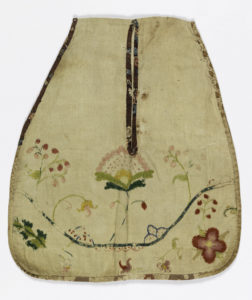
(Cooper Hewitt Museum, 17th c ladies pocket)
As the medieval rural world became more urban and thieves (known as cutpurses) became more prevalent, the pocket migrated inwards. Women’s pockets were tied to their waist under the garment and could be accessed through a slit in their voluminous skirts. Men’s pockets were hidden under tunics because it was assumed they carried more valuable items.
By the 17th century, these tie-on pockets became larger and larger as women began to carry more and more – scent bottles, spectacles, sewing kits, keys, snuffboxes, combs – all found their way into these pockets. The fashions of the time allowed for these larger pockets because the ladies were wearing bustles, bum rolls and panniers, which held the skirt away from the body.
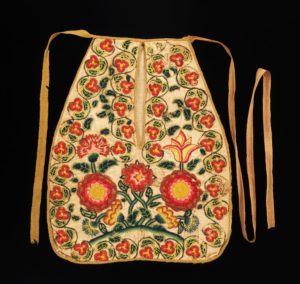
(Metropolitan Museum, 17th C Ladies Pocket)
Then came the French revolution at the end of the 18th century and fashions changed. The decadent use of yards and yards of fabric was no longer acceptable. The Regency period brought with it a new silhouette. Now dresses and skirts were cut closer to the body and women no longer had a handy place to hide their pockets.
Women still needed to carry their belongings, and thus was born the highly decorative, but very small reticule. The early reticules were drawstring bags carried on the wrist. No longer a private hiding place, the handbag was now on public display.
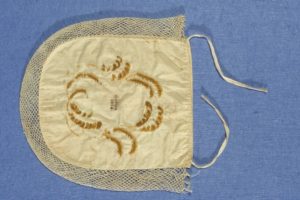
1985.0641.01, Smithsonian Insitute, silk & cotton
Around 1830, chatelaines came into use. Because one could only carry so much weight in the reticule, the chatelaine became the prominent device for carrying heavier sewing tools such as tiny scissors, needle cases, thimbles and household keys. This oversized charm bracelet was worn, jingling, either around the waist or on a chain around the neck, again all on public display.
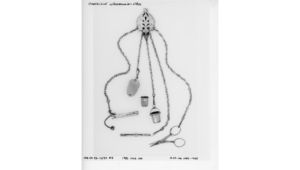
Smithsonian Institute, Chatelaine
According to an article by Chelsea Summers (The Politics of Pockets, Vox 9/19/2016), women’s tie-on pockets had allowed a great measure of freedom, permitting them to carry any number of items including potentially seditious and amorous materials in complete privacy. Once tie-on pockets went away and women’s possessions were out on public display, it began to limit women’s ability to navigate public spaces or travel independently. Thieves and pickpockets could see what the ladies were carrying and size them up for potential loot.
At the same time, men found a need to carry more stuff and soon their suits of clothes sported up to 15 pockets. While a Scotsman wearing a pocketless kilt found a sporran a handy container, most European men migrated from the tie-on pocket to many-pocketed suits.
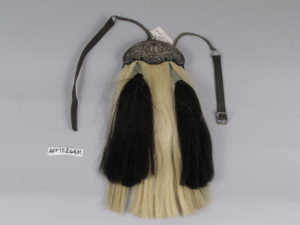
Sporran. AF*75264M.
By 1891, the Rational Dress Society was founded and called for women to dress for health: no more corsets or boned clothing. Instead, they were encouraged to wear bloomers and loose trousers that allowed for movement and activities such as bicycling and tennis.
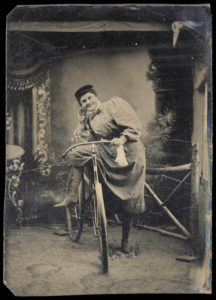
(Smithsonian Institute tintype)
Bicycle costumes contained an abundance of pockets, even for pistols. Many women were reluctant to tell their clothing maker they wanted pistol pockets but gave themselves away when asking the pocket to be lined with canvas duck or leather. And this was occurring at least 20 years before the 19th Amendment.
Flash forward to the 21st century, women are still dealing with fake, sewn-shut pockets on suits, tiny pockets on jeans, and we still must carry a handbag for our stuff, but fashion is slowly moving forward. Women can now purchase or sew trousers and multi-pocketed cargo pants, and while vests with pockets cut for a woman’s body are primarily seen at fishing holes, they are slowly surfacing as travel wear.
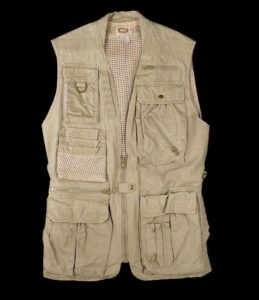
I have an old, well loved and worn Banana Republic journalist’s vest that I absolutely love for hiking and traveling. It has a zillion zippered pockets and frees my hands up at the airport; I just wish I wouldn’t get such weird stares from the TSA people. One pocket at a time…